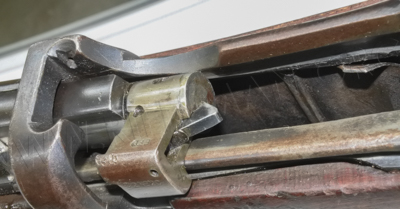
Please be aware that some specialist imagery may take time to load.
This site is designed for dedicated researchers on desktop or tablet, not ideal for mobile browsing.
See also: the .22LR SMLE No.2 Mk.IV* & Mk.III Training Rifles
and another SHORTENED SMLE .22 RIFLE ...... - ......or the AUSTRALIAN SHORTENED LIGHTENED SMLE
This rifle was part of the original Enfield Pattern Room collection
that was gifted by the Ministry of Defence to the Royal Armouries (Leeds) in 2007.
Photography by Rifleman
by courtesy of the Royal Armouries, who hold joint copyright.
The rifle is now part of the National Firearms Collection as object no. PR.587
and is deemed to possibly be an experimental carbine-type model.

It was originally an SMLE Mk.III-star (Rifle, Short, Magazine, Lee-Enfield) in .303in. service calibre, before being subsequently modified by Parker-Hale ca. 1925 in the manner of the .22RF No.2 Mk.IV* training rifle. The Royal Armouries listing shows the rifle as a .22 Pattern '14 model, but those were conversions of earlier "Long" Lee-Metfords/Enfields at a time when service SMLEs were too strategically valuable to convert.
The stencilled marks on the butt suggest that the rifle underwent a Factory Thorough Repair in February of 1955 (note "FTR" on butt-stock RHS), but there is also a possibility that the butt-stock has been replaced at some time. However, the patina of both butt and fore-end furniture are much as one would expect of such a well used old long-arm. If the rifle was shortened prior to 1955, it is unlikely, as a non-standard example, to have been sent to an FTR centre such as Weedon.

The overall length is fractionally under 40 inches,
compared with 44¼ inches of the issue S.M.L.E.

The above overlay of this rifle on a standard rifle shows the difference.
All the length reduction is forward of the barrel band.

The tangent rear-sight lacks the later windage adjustable addition
enjoyed by many .22 converted rifles, and has no additional short range calibration.

As was usual with such .22RF conversions, only the shell of the magazine is used
as a receptacle for the extracted fired empty cartridge cases.


The action is of 1916 Enfield manufacture

But the butt is stamped with a London Small Arms Company cartouche.

Below: the shortened distance between barrel band and nose-cap.
The nose-cap itself is 5¼ inches long, and the distance between the rear of the nose-cap and the barrel band is 7 inches on an issue rifle. The latter measurement on the shortened rifle is just 2⅝ inches, meaning the rifle is 4⅜ inches shorter than standard.

The weight of this rifle is a fraction of an ounce over 9 pounds,
when an issue rifle weighs approximately 8lbs. 3ozs.
Strangely, a full-length .22 No.1 Mk.III rifle we have weighed came out at 8lbs. 15ozs. - about one-and-a-half ounces less than this shortened rifle.
We would have expected a significant weight saving. particularly as our rifle still carries the magazine cut-off when the shortened rifle does not. Possibly the wood of the latter is denser and the butt of greater length.
It should be pointed out that the .22 rifles usually weigh more than the .303 service rifles, as the larger bore of the latter means there is less weight in the barrel.
Below: the receiver ring carries a "Parker-Hale" mark,
and the barrel's reinforce is stamped with their initials "PH"

The serial number is "Y 2066"

The bolt-head is an Enfield R.S.A.F. product,
not of Parker-Hale manufacture, .......

...... and of the type ".22No. 2C"
The third generation of the .22 No.2 bolt-heads.

The receiver ring carries the 'crossed pennants' military proof mark

The breech of the barrel's .22RF rifled sleeve and recessing for the rimfire cartridge's rim can be clearly seen, with the groove for the extractor.
Finger-fed hand-loading is the order of the day,
with many a live round inadvertently dropped into the magazine
in that fiddly process.

The rimfire extractor and offset firing pin

See also: the .22LR SMLE No.2 Mk.IV* & Mk.III Training Rifles
and another SHORTENED SMLE .22 RIFLE ...... - ......or the AUSTRALIAN SHORTENED LIGHTENED SMLE
Return to: TOP of PAGE
See this website's Raison d'être